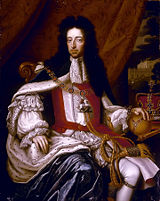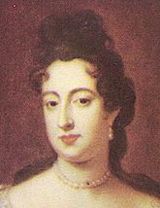William and Mary
2008/9 Schools Wikipedia Selection. Related subjects: British History 1500-1750; Monarchs of Great Britain
The phrase William and Mary usually refers to the joint sovereignty over the Kingdom of England, as well as the Kingdom of Scotland, of King William III and his wife Queen Mary II, a daughter of James II. Their joint reign began in February, 1689, when they were called to the throne by Parliament, replacing James II, who was "deemed to have fled" the country in the Glorious Revolution of 1688. After Mary died in 1694, William of Orange ruled alone until his death in 1702. Their rule was the only period in British history in which "joint sovereigns" with equal powers were allowed to reign; usually, the spouse of the monarch has no power and is simply a consort.
Historic impact
To end the Glorious Revolution, William and Mary signed the English Bill of Rights, and a new co-operation between the Parliament and the monarchs, leading to a greater measure of personal liberty and democracy in Britain. This action both signaled the end of several centuries of tension and conflict between crown and parliament, and the end of the idea that England would be restored to Roman Catholicism, King William being a Protestant leader.
The English Bill of Rights also inspired the colonists in the Americas to revolt in Massachusetts, New York, and Maryland.
The College of William & Mary in Williamsburg, Virginia, was chartered in 1693, endowed and named in their honour.

